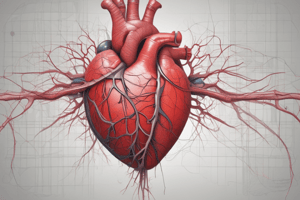Podcast
Questions and Answers
What is the focus of physiology in the study of the body?
What is the focus of physiology in the study of the body?
- The structure of bones
- The functions and processes of the body (correct)
- The disorders of bone structure
- The composition of cells
Which type of tissue primarily covers body surfaces?
Which type of tissue primarily covers body surfaces?
- Muscle tissue
- Nerve tissue
- Connective tissue
- Epithelial tissue (correct)
What distinguishes organic molecules from inorganic molecules?
What distinguishes organic molecules from inorganic molecules?
- Organic molecules do not contain oxygen
- Inorganic molecules are larger and more complex
- Organic molecules are always found in living organisms
- Organic molecules contain carbon and hydrogen (correct)
What is the primary function of connective tissue?
What is the primary function of connective tissue?
Which of the following best describes an organ?
Which of the following best describes an organ?
Which of these systems is responsible for transporting materials throughout the body?
Which of these systems is responsible for transporting materials throughout the body?
Which system is responsible for producing blood cells?
Which system is responsible for producing blood cells?
What is the function of the lymphatic system?
What is the function of the lymphatic system?
What is the definition of metabolism?
What is the definition of metabolism?
Which area is referred to as the thigh?
Which area is referred to as the thigh?
What is the function of the integumentary system?
What is the function of the integumentary system?
What is the function of the nervous system?
What is the function of the nervous system?
What is the definition of homeostasis?
What is the definition of homeostasis?
What type of feedback reinforces a change?
What type of feedback reinforces a change?
Flashcards are hidden until you start studying
Study Notes
Key Definitions
- Anatomy focuses on the structure of bones.
- Physiology examines bodily functions and processes.
- Pathophysiology investigates disorders affecting body function.
Levels of Organization
Chemicals
- Inorganic compounds are simple, composed of one or two non-carbon elements (e.g., water, oxygen).
- Organic compounds are complex, containing carbon and hydrogen (e.g., carbohydrates, fats, proteins, nucleic acids).
Cells
- The fundamental units of life, composed of various chemicals performing specific functions.
Tissues
- Collections of similar cells working together.
- Epithelial tissue: Covers body surfaces (examples include skin and capillaries).
- Connective tissue: Provides support and transport (includes blood and cartilage).
- Muscle tissue: Facilitates movement through contraction.
- Nerve tissue: Responsible for transmitting impulses (e.g., brain and spinal cord).
Organs
- Complex structures made of tissues working toward specific functions (e.g., kidneys, liver).
Organ Systems
- Combinations of organs that perform related physiological functions (e.g., the urinary or digestive systems).
Organ Systems Overview
- Integumentary System: Protects against pathogens and regulates water loss; includes skin and subcutaneous tissue.
- Skeletal System: Supports the body, protects organs, and produces blood cells; comprises bones and ligaments.
- Muscular System: Facilitates movement and heat production through muscles and tendons.
- Nervous System: Processes sensory information and controls body functions using the brain, nerves, and sensory organs.
- Endocrine System: Manages body functions and metabolism through hormones; includes glands like the thyroid and pituitary.
- Circulatory System: Responsible for transporting oxygen, nutrients, and waste; consists of the heart and blood vessels.
- Lymphatic System: Maintains fluid balance, immune response; involves the spleen and lymph nodes.
- Respiratory System: Manages gas exchange (oxygen and carbon dioxide) in the lungs and airways.
- Digestive System: Processes food into absorbable nutrients using organs like the stomach and pancreas.
- Urinary System: Eliminates waste products and regulates blood volume and pH; includes kidneys and bladder.
- Reproductive System: Produces gametes and supports fetal development; involves ovaries and testes.
Metabolism and Homeostasis
- Metabolism encompasses all chemical reactions in the body, including those for energy production.
- Homeostasis refers to maintaining stable internal conditions.
- Negative feedback mechanisms counteract changes to keep variables within normal limits.
- Positive feedback mechanisms amplify changes, as seen during childbirth.
Body Parts and Areas
- Antebrachial: Refers to the forearm.
- Antecubital: Located at the front of the elbow.
- Axillary: Pertains to the armpit region.
- Brachial: Relates to the upper arm.
- Buccal: Refers to the mouth area.
- Cardiac: Related to the heart.
- Cervical: Indicates the neck region.
- Cranial: Pertains to the head area.
- Femoral: Refers to the thigh.
- Frontal: Indicates the forehead.
- Gastric: Pertains to the stomach.
- Gluteal: Relates to the buttocks.
- Hepatic: Pertains to the liver.
- Iliac: Indicates the hip area.
- Inguinal: Refers to the groin region.
- Lumbar: Pertains to the lower back.
Studying That Suits You
Use AI to generate personalized quizzes and flashcards to suit your learning preferences.





